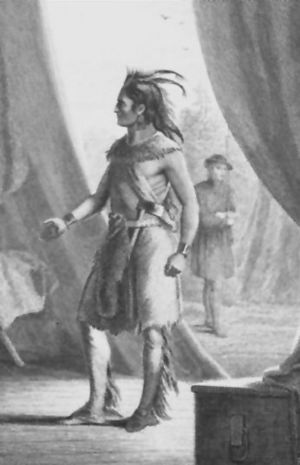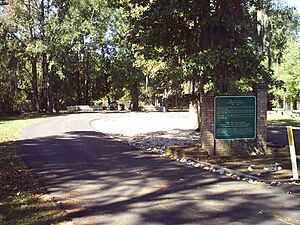William Weatherford facts for kids
Quick facts for kids
William Weatherford
|
|
|---|---|
 |
|
| Creek Leader of the Red Sticks | |
| Personal details | |
| Born | 1765 or 1780 Koasati village |
| Died | March 24, 1824 Monroe County, Alabama |
| Nickname | Red Eagle |
| Military service | |
| Battles/wars | |
William Weatherford, also known as Red Eagle, was an important Creek chief. He was born around 1765 and died on March 24, 1824. He led many actions for the Red Sticks during the Creek War (1813–1814). The Red Sticks fought against other Creek towns and the United States.
William Weatherford had a mixed background. His family included Creek, French, and Scottish people. He grew up as a Creek, following their traditions. He gained his power through his mother's important Wind Clan. After the war, he became a successful farmer in Monroe County, Alabama.
Contents
Who Was William Weatherford?
William Weatherford was born in 1781 near the Creek town of Coosauda. This area is close to what is now Coosada, Alabama. His mother, Sehoy III, was from the powerful Wind Clan of the Creek people. His father, Charles Weatherford, was a Scottish trader. He married Sehoy III after her first husband died.
The Creek people had a matrilineal system. This means children belonged to their mother's clan. So, William was considered part of his mother's Wind Clan. His father had a trading post and raised horses.
William was called "Billy" when he was young. Later, he earned the war name Hopnicafutsahia, meaning "Truth Teller." He was related to other important Creek leaders. His uncle was Chief Alexander McGillivray. He was also a cousin of William McIntosh, a chief of the Lower Creek towns.
Weatherford's Life and Role
William Weatherford learned both Creek traditions and the English language. As a young man, he started a farm in the Upper Creek territory. He owned slaves and grew crops to sell. He also bred and raced horses, like his father.
He usually got along well with both Creek people and European Americans. However, he worried about the growing number of settlers. These settlers were moving onto Creek land.
Differences Among Creek People
The Creek Nation had two main groups: the Upper Creek and the Lower Creek. The Lower Creek towns were closer to European Americans. They adopted more of their customs. The Upper Creek towns were more traditional. They did not want to change their ways.
Weatherford and other Upper Creek leaders were upset. They saw settlers taking their land. This land was in what the United States called the Mississippi Territory. This area is now part of Alabama.
In 1811, the Americans improved a road called the National Road. More settlers came, claiming land for farms. Some Creek groups, especially the Upper Creek, fought back. The Lower Creek towns had already given up land to the U.S. in earlier treaties.
The Lower Creek were part of the Five Civilized Tribes. They adopted some American farming methods. This helped them keep their communities. But the Upper Creek resisted these changes. Weatherford first tried to stay neutral in these conflicts.
The Red Sticks Movement
Conflict grew within the Creek Nation. Some wanted to adapt, while others wanted to keep old traditions. Leaders of the Upper Creek began talking with Spanish and British officials. They wanted allies against the United States.
Those who wanted to fight became known as the Red Sticks. They became a powerful group among the Creek. Red Stick groups went to Spanish Florida to buy weapons.
Americans found out the Red Sticks were getting weapons. A militia group attacked a Red Stick party at Burnt Corn Creek. The Red Sticks were bringing weapons back from Pensacola. The Americans tried to take the weapons, but the Red Sticks fought them off. After this, the Creek "declared war" on the United States. The British, who were already fighting the U.S. in the War of 1812, supported the Creek resistance.
The Creek War and Fort Mims
Weatherford joined the Red Sticks. They tried to push American settlers out of Creek land. In August 1813, Weatherford and other Red Sticks attacked Fort Mims. This was a fort on the Alabama River. American families and Lower Creek people had gathered there for safety.
The Red Sticks entered the fort. They killed many people, including Lower Creek and American settlers. About 500 people died. Only about 35 survived. Weatherford was a leader, so he was held responsible. However, some reports say he tried to stop the killing.
Battles and Surrender
An Alabama militia chased the Red Sticks. They fought at the Battle of Holy Ground. Weatherford narrowly escaped capture. He jumped from a cliff into the Alabama River while on horseback.
Major General Andrew Jackson led an army of state militias. Jackson's army trapped the main Red Stick Army at the Battle of Horseshoe Bend. Weatherford helped some Red Stick groups escape. But most of the Red Sticks were defeated.
Weatherford and about 200 other Red Sticks escaped. Many went to Florida and joined the Seminole people. Weatherford surrendered at Fort Jackson. Jackson spared Weatherford's life. He used Weatherford's influence to help other Upper Creek chiefs make peace.
Weatherford helped negotiate a new treaty with the U.S. The Creek lost some land, but they kept most of their territory. Weatherford then moved to Monroe County, Alabama. He rebuilt his wealth as a farmer. He died there in 1824. About ten years later, the U.S. forced most Creek people to move west of the Mississippi River. This event is known as Indian removal.
Family Life
William Weatherford married Mary Moniac. They had two children, Charles and Mary. After Mary died, he married Sopethlina Kaney Thelotco Moniac. They had a son, William Weatherford, Jr. She died after his birth. Around 1817, Weatherford married Mary Stiggins. They had several children, including Alexander McGillivray Weatherford and Mary Levitia Weatherford.
Weatherford's nephew, David Moniac, was the first Native American to graduate from the United States Military Academy at West Point. William Weatherford might have been related to the Shawnee chiefs Tecumseh and Tenskwatawa. This connection may have helped form a strong alliance between them during the Indian Wars.


